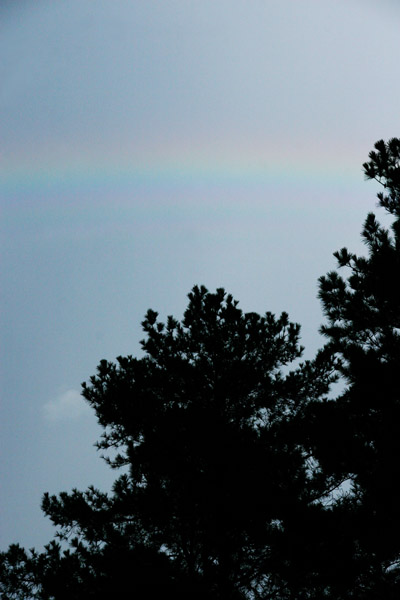 Friday evening, the rain decided to throw down (it was certainly much harder than falling,) and typically for the weather we’re having this year, it passed quickly. As the sun returned, I checked to see if we were having a rainbow, but saw nothing. Turns out it was only being fashionably late, and wasn’t terribly bright when it arrived, but as The Girlfriend and I looked towards the top of the arc, we could distinctly see something that I first witnessed almost exactly a year ago. I ran in to get the camera, and it had faded to a degree in that short time, but I still managed to capture enough to illustrate this again. This image has slightly enhanced contrast to make it more evident.
Friday evening, the rain decided to throw down (it was certainly much harder than falling,) and typically for the weather we’re having this year, it passed quickly. As the sun returned, I checked to see if we were having a rainbow, but saw nothing. Turns out it was only being fashionably late, and wasn’t terribly bright when it arrived, but as The Girlfriend and I looked towards the top of the arc, we could distinctly see something that I first witnessed almost exactly a year ago. I ran in to get the camera, and it had faded to a degree in that short time, but I still managed to capture enough to illustrate this again. This image has slightly enhanced contrast to make it more evident.
Supernumerary rainbows are a partial repetition of the prism pattern on the underside of the main bow (there are often two, with the primary one being brighter and lower,) an optical ‘echo’ of sorts. Last year, my sources had indicated that we didn’t actually know how they occurred, which it turns out is partially true. Looking it up again this year, I found a better source which not only explains that the size of the rain droplets has a lot to do with it, you can even see the difference in effect with raindrop size by playing with their little doodad on the site. According to them there editors at Atmospheric Optics, the smaller the raindrop, the more distinct the inner bows tend to be – which is exactly the opposite of what I would have expected, given the conditions in which I’ve seen them both times. However, I was not out witnessing the rain at the tail end of the summer squall, so maybe the raindrops got smaller as it passed, shoved out of their place in the lunch line by the bigger bully drops.
Photographing rainbows is a bit like sunsets (mentioned in the previous post,) but probably takes even more effort. Bracketing heavily in both exposure and contrast settings is recommended, since the camera is less capable of discerning the subtle contrast differences that our eyes can see, and the exposure meter will be affected by pointing up into the sky. Achieving ideal brightness and saturation is therefore tricky, and it’s very easy to get nothing at all like what you were seeing unless you really work at it.
 This is the same image, but with saturation thrown way the hell up – there will be another version at the bottom of this post. Now the additional bands below the main bow are plainly visible, reducing in width and starting to give a three-dimensional effect, as if numerous bows were stacked alongside one another into the distance, and we’re seeing their undersides. This is not the case, since rainbows are an optical phenomenon of light
This is the same image, but with saturation thrown way the hell up – there will be another version at the bottom of this post. Now the additional bands below the main bow are plainly visible, reducing in width and starting to give a three-dimensional effect, as if numerous bows were stacked alongside one another into the distance, and we’re seeing their undersides. This is not the case, since rainbows are an optical phenomenon of light diffraction refraction and thus don’t really have a ‘distance’ – you can’t get closer to them, thus all the folklore about “over” and “beyond” and “at the end of” rainbows, which like the horizon are always distant and unattainable. In other words, it’s all cruel mocking.
As another small aside, shooting photos of this nature is a very good way to find out just how much dust and schmutz is on your digital sensor, more than a little annoying to me because it’s very tricky to remove it in the image, especially around the color bands themselves, and because I just cleaned the damn thing before I went to the beach. It must be pleasant to be a studio photographer who changes lenses in a nice clean environment all the time…





















































